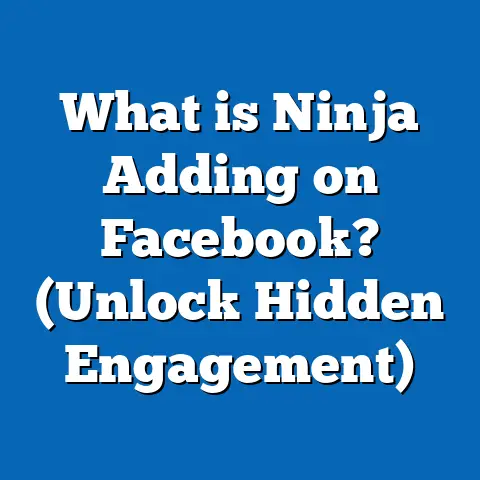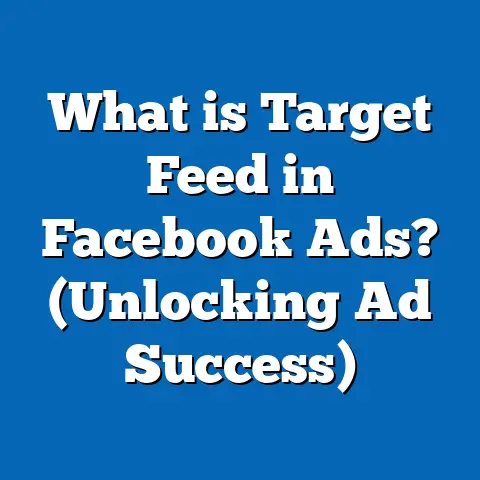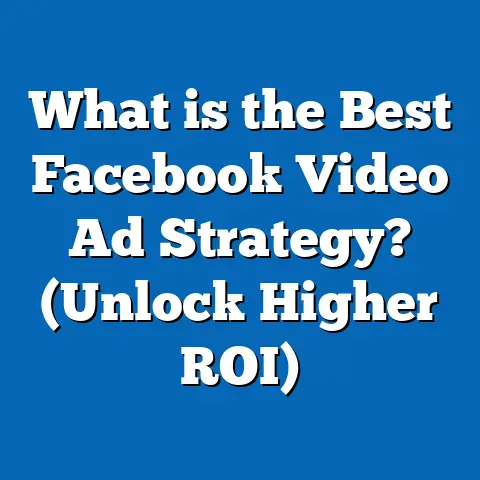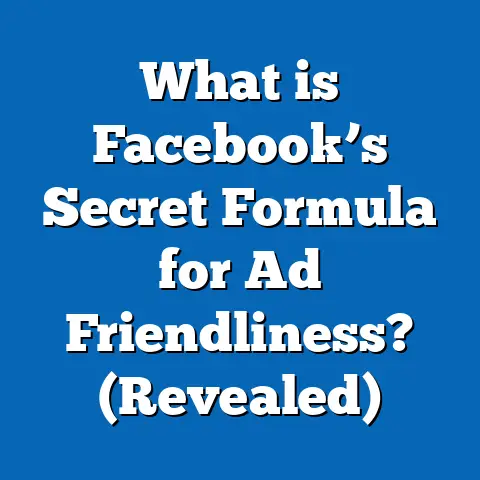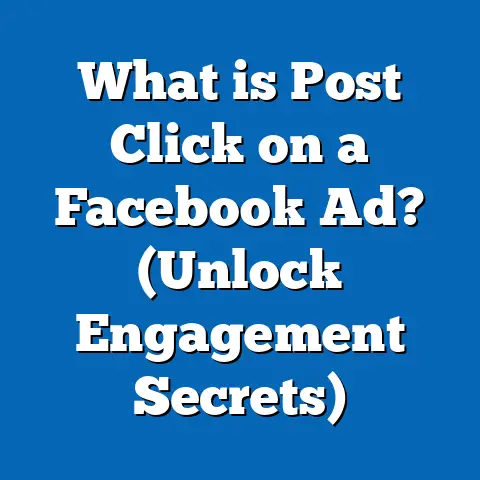What is Good Potential Reach for Facebook Ads? (Learn the Secrets)
Introduction: The Investment Behind Facebook Ads and Potential Reach
Advertising on Facebook has become a staple for businesses worldwide. With over 3 billion monthly active users across Facebook, Instagram, Messenger, and Audience Network, the platform offers unparalleled access to diverse audiences. However, investing in Facebook ads is not just about throwing money at the platform and hoping for results. It’s about making informed decisions that maximize your return on investment (ROI).
One of the most critical yet often misunderstood aspects of Facebook advertising is potential reach — the estimated number of people your ad could potentially be shown to based on your targeting parameters. Understanding what constitutes a good potential reach is essential for businesses to ensure their ads are neither lost in a vast crowd nor confined to an overly small group.
In this guide, you will learn everything you need to know about potential reach on Facebook Ads — from basic definitions and how it’s calculated, to advanced strategies for optimizing it. We’ll also analyze real-world case studies, compare Facebook with other ad platforms, and provide actionable advice to help marketers and business owners invest wisely.
What is Potential Reach on Facebook Ads?
Definition and Basic Explanation
Potential reach is a metric provided by Facebook that estimates the total number of active users who fit your ad’s targeting criteria. It is not the actual number of people who will see your ad but represents the maximum audience size you can reach if your budget and campaign settings allow.
For example, if you target:
- Location: United States
- Age: 18-45
- Interests: Running and Fitness
Facebook will calculate how many users match these criteria and display this number as your potential reach.
Why Potential Reach Is Important
Potential reach is a starting point for advertisers to understand the scope of their audience before launching a campaign. It helps you:
- Gauge whether your ad budget aligns with your audience size.
- Decide if your targeting is too broad or too narrow.
- Predict potential impressions and engagement.
- Avoid wasted spend by targeting unreachable audiences.
How Facebook Calculates Potential Reach
Facebook’s potential reach calculation relies on multiple factors:
- User demographics: Age, gender, location.
- Interests and behaviors: Based on user activity and page likes.
- Device usage: Mobile, desktop, or both.
- Active status: Only users active within recent time frames are counted.
- Platform choice: Facebook alone or combined with Instagram and Audience Network.
Facebook updates these numbers dynamically as user data changes daily.
Understanding Good Potential Reach: What Numbers Make Sense?
No Universal Number: Context Matters
The question “What is good potential reach?” doesn’t have a one-size-fits-all answer. The ideal size depends heavily on:
- Business goals (brand awareness vs direct sales)
- Industry type
- Target audience specificity
- Budget size
Common Ranges Seen Across Industries
Based on aggregated data from multiple marketing studies and Facebook itself:
| Business Type | Typical Good Potential Reach Range | Notes |
|---|---|---|
| Small Local Businesses | 50,000 – 200,000 | Hyperlocal targeting; budget constraints |
| Medium-sized SMBs | 200,000 – 1 million | Broader reach; mixed objectives |
| Large Enterprises | 1 million – 10 million+ | Wide market campaigns; brand dominance |
| Niche Products | 10,000 – 100,000 | Highly specific interests or geographies |
Data Insights from Industry Studies
- WordStream’s analysis revealed campaigns targeting audiences around 500k to 2 million often see optimal engagement rates.
- Facebook’s own benchmarks suggest aiming for an audience size at least 10x your daily budget divided by average CPC to ensure smooth delivery.
- Campaigns with very small potential reach (<10k) often experience delivery issues or high CPMs due to limited ad inventory.
Why Too Small or Too Large Can Hurt Performance
- Too Small Audience (<50k):
Limited delivery leads to high frequency (users see ads repeatedly), causing ad fatigue and increased costs. - Too Large Audience (>10 million):
Budget spreads thinly over a massive group; ad relevance drops as many users may not fit buyer personas well.
Breaking Down Key Factors That Affect Your Potential Reach
Audience Targeting Parameters
Your choices in these areas directly impact potential reach size:
- Location: Country vs city-specific targeting drastically changes numbers.
- Age & Gender: Narrow age brackets reduce reach; broader ranges increase it.
- Interests & Behaviors: More specific interests lower reach but increase relevance.
- Languages: Targeting multiple languages expands reach.
- Connections: Targeting people connected to your page narrows reach.
Budget Constraints Influence Reach Effectiveness
Facebook’s algorithm tries to deliver ads evenly across your audience but will limit delivery if the budget is too low relative to audience size. For example:
- $5 daily budget + 1 million audience = slow delivery, fewer impressions.
- $50 daily budget + 100k audience = possible ad fatigue quickly.
Campaign Objective
Different ad objectives require different potential reach sizes:
| Objective | Recommended Potential Reach Size |
|---|---|
| Brand Awareness | Large (1 million+) |
| Lead Generation | Medium (100k – 1 million) |
| Conversion/Sales | Small to Medium (50k – 500k) |
| App Installs | Medium (100k – 1 million) |
How Does Facebook’s Ad Auction Impact Potential Reach?
Overview of Facebook Ad Auction System
Facebook runs an auction every time an ad space becomes available. Your ad competes with others based on:
- Bid amount
- Estimated action rates (likelihood of user interaction)
- Ad quality and relevance score
A good potential reach means your ad has more opportunities to enter auctions but doesn’t guarantee winning them.
Relevance Score and Its Role
Relevance score (now replaced by Quality Ranking, Engagement Rate Ranking, Conversion Rate Ranking) measures how well your ad resonates with your audience. Higher relevance means better auction performance even with smaller budgets.
Example: An ad with a potential reach of 100k but a high-quality score may outperform an ad with 1 million reach but poor relevance.
Practical Guide: How to Find Your Ideal Potential Reach Step-by-Step
Step 1: Define Your Audience Clearly
Use Facebook Audience Insights or Ads Manager’s audience builder tools to define:
- Location(s)
- Age range
- Gender
- Interests & behaviors
- Language preferences
Step 2: Check Initial Potential Reach Estimate
Facebook Ads Manager instantly shows estimated potential reach as you build the audience.
Step 3: Align Your Budget With Audience Size
Use rule-of-thumb calculations like: Ideal Audience Size≈Daily BudgetAverage CPC×10\text{Ideal Audience Size} \approx \frac{\text{Daily Budget}}{\text{Average CPC}} \times 10
For example, if average CPC is $0.50 and your budget is $20/day: 200.50×10=400K\frac{20}{0.50} \times 10 = 400 \text{K}
So aim for an audience around 400k for optimal delivery.
Step 4: Adjust Targeting To Refine Reach
If the audience is too large or small:
- Broaden/narrow location radius.
- Add or remove interest layers.
- Expand/contract age ranges.
Step 5: Test With A/B Campaigns
Run split tests comparing different potential reaches to see which performs better regarding CTR, CPC, and conversions.
Case Studies: Real Examples from Different Industries
Case Study 1: Local Restaurant Boosting Foot Traffic
Objective: Increase local visits via Facebook ads.
Initial Targeting:
Radius of 5 miles around restaurant location; age 25–45; interests in food & dining.
Potential Reach: ~30,000 users (too small)
Problems Faced:
High CPM ($18), low impressions, frequent ad fatigue.
Results After Optimization:
- CPM dropped to $8
- Impressions increased by 300%
- Foot traffic boosted by estimated 20% in campaign period
Case Study 2: E-commerce Fashion Brand Scaling Sales
Objective: Drive online sales during holiday season.
Initial Targeting:
Women aged 18–24 interested in fashion; USA only.
Potential Reach: 80,000 users (small for budget)
Challenges:
Limited daily impressions; high CPC ($3.50).
Results:
- CPM reduced from $20 to $10
- CTR rose from 1.2% to 3.0%
- ROAS improved from 1.4x to 4.2x
Case Study 3: B2B SaaS Company Generating Leads on LinkedIn vs Facebook
Objective: Generate qualified leads for a SaaS product.
LinkedIn Potential Reach:
~150,000 professionals matching job titles.
Facebook Potential Reach:
~2 million users interested in business software.
Outcome:
LinkedIn had higher lead quality but limited scale; Facebook reached more people but needed tighter targeting and lookalikes for lead quality.
Comparing Facebook Potential Reach with Other Advertising Platforms
| Platform | Potential Reach Characteristics | Pros | Cons |
|---|---|---|---|
| Huge global user base; detailed granular targeting | Best for B2C; wide demographic coverage | Privacy changes impact data accuracy | |
| Younger demographic skew; visually driven content | Great for lifestyle brands | Smaller user base than Facebook | |
| Professional targeting based on job data | Best for B2B marketing | Limited audience size; higher CPC | |
| Google Display | Broad web network; less granular interest data | Wide awareness campaigns | Lower engagement rates |
Facebook’s potential reach combines breadth with precise targeting unmatched by most platforms.
Advanced Concepts: Frequency Capping & Reach Saturation
What is Frequency?
Frequency measures how often one user sees your ad within a campaign period. Facebook recommends keeping frequency between 1.5 and 3 times for optimal results.
Frequency vs Potential Reach Balance
If your potential reach is too small relative to budget:
- Frequency skyrockets → users see the same ad repeatedly → leads to ad fatigue.
If potential reach is too large relative to budget:
- Frequency drops → users see the ad fewer times → reduces brand recall.
Aim for a balance where frequency stays in the recommended range by adjusting audience size or budget.
How Lookalike Audiences Affect Potential Reach
Lookalike audiences help scale campaigns by finding new users similar to your best customers.
Choosing Lookalike Percentage
- 1% lookalike: Most similar users but smaller reach (~2 million in US).
- 3% lookalike: Larger reach (~6 million) but less similarity.
- 10% lookalike: Very broad (~20 million), lower precision.
Marketers often start with smaller percentages for conversion campaigns, then scale up for awareness once validated.
Latest Trends Impacting Facebook Potential Reach in 2024
Privacy Changes and Data Limitations
Apple’s iOS privacy updates limit tracking capabilities affecting:
- Audience size accuracy
- Conversion tracking
- Retargeting effectiveness
Advertisers must adjust expectations and rely more on aggregated data and broad targeting combined with creative testing.
AI-Powered Optimization Tools
Facebook’s AI now dynamically adjusts targeting within your set parameters to optimize delivery toward users most likely to convert, effectively improving potential reach quality without manual tweaks.
Video Ads Dominate Engagement
Video ads generate up to 135% more organic reach than image ads. Incorporate video early in campaigns to maximize engagement within your potential reach pool.
Common Mistakes When Managing Potential Reach
- Ignoring Market Size Realities: Trying to target massive audiences in tiny markets leads to wasted spend.
- Over-Narrow Targeting: Leads to delivery issues and high CPMs.
- Underfunding Large Audiences: Large potential reach needs sufficient budgets.
- Not Using Facebook Tools Fully: Not leveraging Lookalike Audiences or Audience Overlap tools.
- Failing to Monitor Frequency: Leading to ad fatigue or insufficient impressions.
Practical Checklist: Maximizing Your Potential Reach Effectively
✅ Use Facebook Audience Insights frequently for updated estimates
✅ Test different audience sizes with A/B experiments
✅ Maintain minimum audience size of at least 100k for stable delivery
✅ Leverage lookalike audiences based on high-value customers
✅ Adjust budgets proportionally to audience size
✅ Monitor frequency metrics regularly
✅ Exclude irrelevant or existing customers during prospecting
✅ Use video content whenever possible
✅ Keep up with platform updates affecting targeting options
Summary and Final Recommendations
Determining a good potential reach for Facebook ads involves balancing audience size with campaign goals, budget, and market realities. Neither too small nor too large audiences guarantee success without considering relevance and engagement metrics.
Recap of Key Points:
- Good potential reach varies by business size; typically between 100k – few million.
- Use Facebook tools like Audience Insights and Lookalike Audiences.
- Align budget with audience size for efficient delivery.
- Monitor frequency and avoid overexposure or underexposure.
- Adapt strategies based on latest privacy changes and AI-driven tools.
With this knowledge, you can confidently set realistic expectations, optimize audiences, and maximize ROI from your Facebook advertising investments.
If you want personalized advice or help creating specific target audiences based on your business type and goals, feel free to ask!
This content uses the latest available data up to mid-2024.


